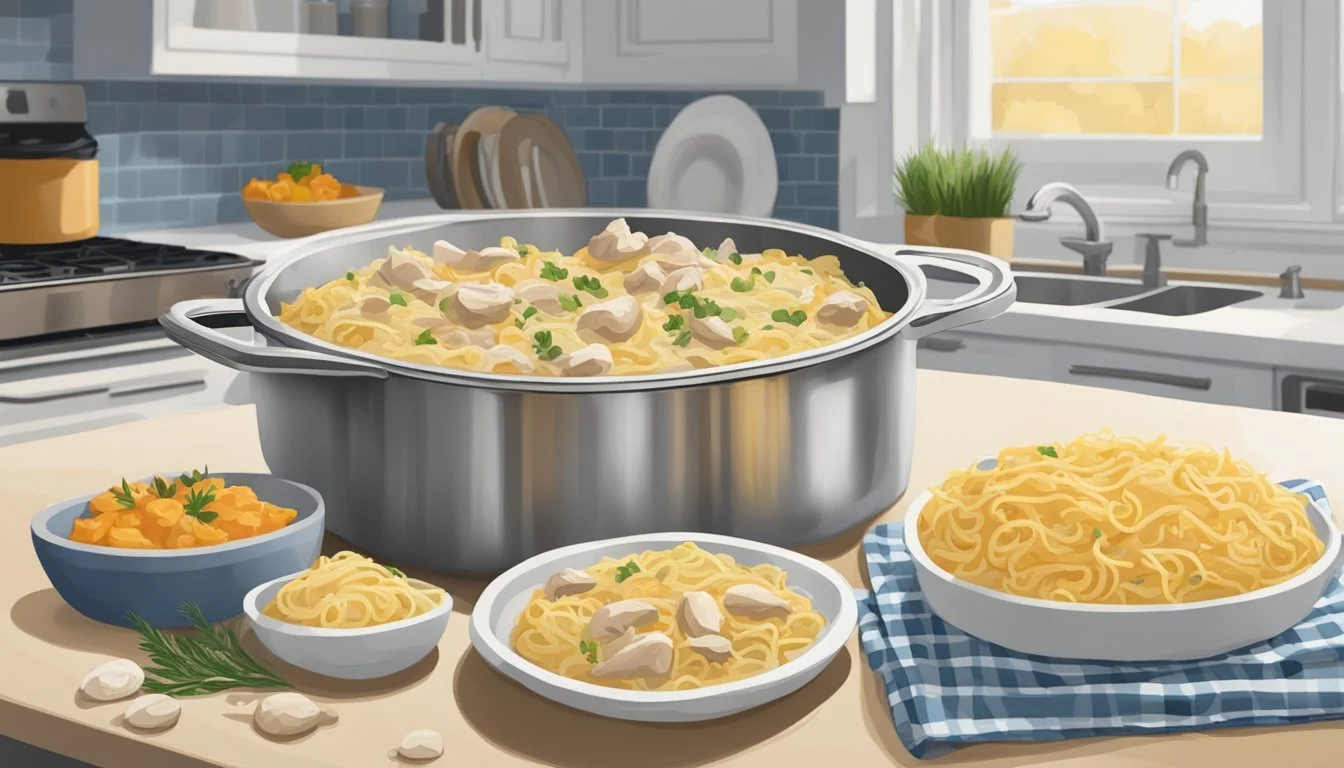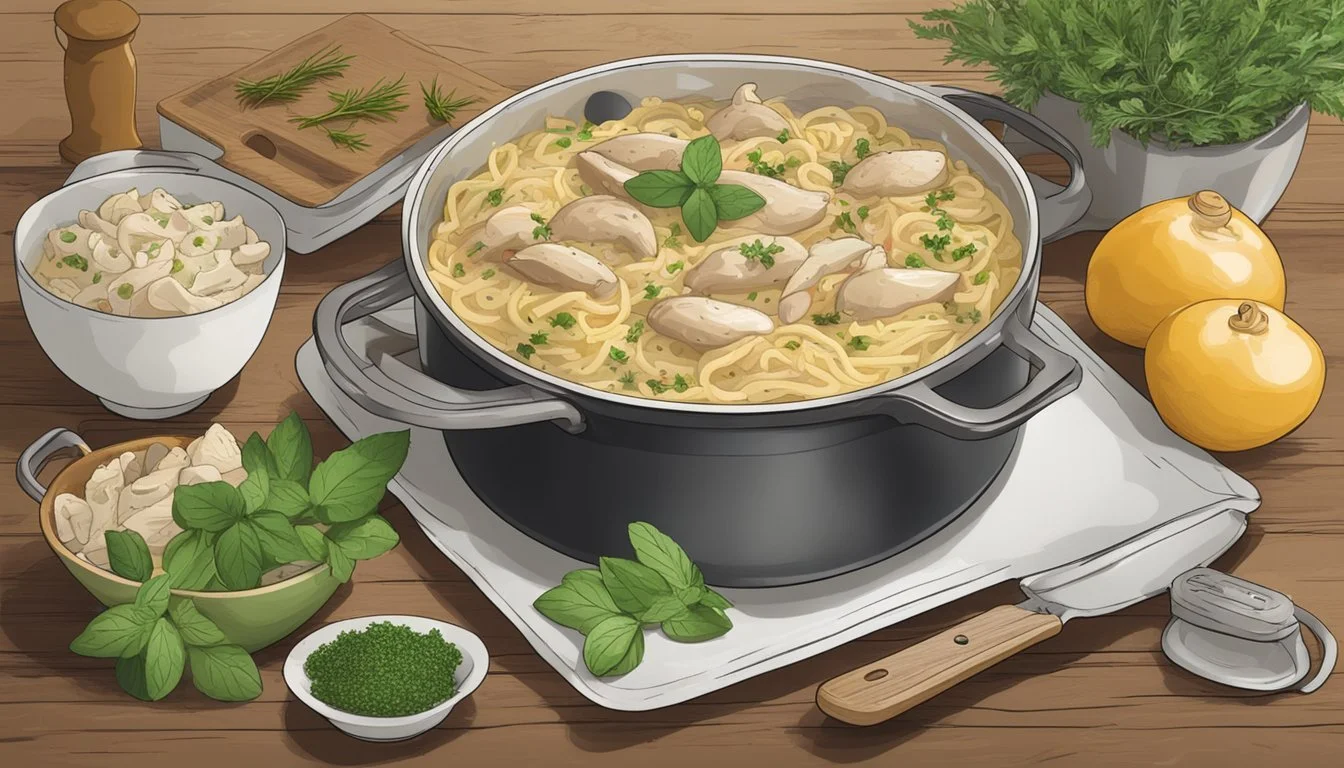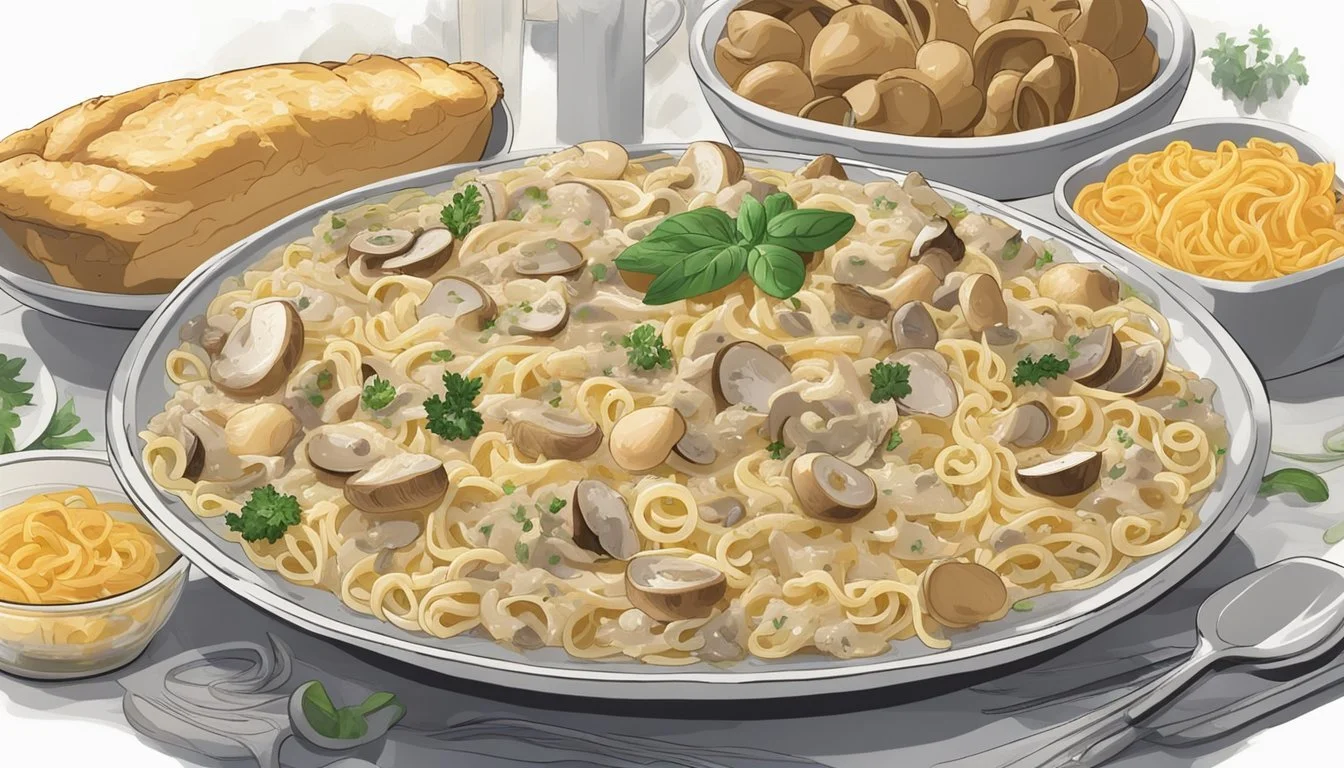How Long Does Chicken Tetrazzini Last?
Storage and Shelf Life
Chicken Tetrazzini is a beloved Italian-American comfort food that combines tender chicken, creamy sauce, and spaghetti into a hearty, satisfying meal. For those who love to prepare this dish in advance or save leftovers for another time, it's essential to know how long it remains fresh. Chicken Tetrazzini lasts about three to four days in the refrigerator when stored properly in an airtight container.
Freezing is a great option if you have a larger batch and want to extend its shelf life. Prepared Chicken Tetrazzini can be stored in the freezer for up to three months, making it a convenient option for meal planning. Ensure it's cooled completely before placing it in a freezer-safe container to prevent ice crystal formation.
Proper storage not only maintains the taste and quality of Chicken Tetrazzini but also ensures food safety. Always reheat it thoroughly before consuming, ensuring it reaches an internal temperature of 165°F (74°C).
Understanding Chicken Tetrazzini
Chicken Tetrazzini is a comforting, creamy pasta bake named after Italian opera star Luisa Tetrazzini. It features an indulgent blend of ingredients like chicken, spaghetti, mushrooms, and Parmesan cheese.
Origins and History
Chicken Tetrazzini was created in the early 20th century to honor Italian opera singer Luisa Tetrazzini. Its exact origins are debated, with various claims from chefs in San Francisco and New York.
The dish became popular in American cuisine, embodying a luxurious yet comforting meal that could be prepared for special occasions or family dinners.
Key Ingredients
The typical ingredients in Chicken Tetrazzini include cooked chicken, spaghetti, a creamy mushroom sauce, and Parmesan cheese. Mushrooms and garlic are common, adding depth of flavor.
The sauce is often made with heavy cream, butter, and chicken broth, providing richness and creaminess. A sprinkle of cheese on top adds a savory, crispy finish.
Typical Recipe and Variations
A standard recipe for Chicken Tetrazzini involves baking cooked pasta and chicken in a casserole dish with a creamy, cheesy sauce. The preparation includes boiling the pasta (often to al dente), making a bechamel or cream-based sauce, and combining everything before baking until bubbly.
Variations include using turkey instead of chicken, adding frozen peas or other vegetables, and switching out Parmesan for other cheeses. Some recipes might incorporate white wine for additional flavor.
Health and Nutrition
Chicken Tetrazzini is a rich, comforting dish with various nutritional components. Its health impact largely depends on the ingredients and preparation methods used.
Caloric Content
Chicken Tetrazzini typically ranges between 400 to 600 calories per serving. This amount can vary based on factors such as portion size and specific ingredients. Using full-fat dairy products and cream soups increases the calorie count, while opting for low-fat or non-dairy alternatives can help lower it.
Macronutrients Breakdown
Protein: Chicken Tetrazzini provides a significant amount of protein, often around 20-30 grams per serving, mainly from the chicken and any added cheese.
Fat: The fat content can be high, usually between 15-30 grams per serving. Butter, cream, and cheese contribute most to the fat content. Reducing these ingredients minimizes fat intake.
Carbohydrates: This dish typically contains a moderate amount of carbohydrates, around 40-60 grams per serving, primarily from pasta. Whole-wheat pasta can be used to increase fiber content.
Dietary Considerations
Cholesterol and Sodium: These values can be substantial in traditional recipes due to heavy cream, butter, and cheese. One serving often contains around 100-150 mg of cholesterol and 600-900 mg of sodium.
Potassium: Vegetables like mushrooms and onions add essential nutrients such as potassium, which is vital for heart health.
Fiber: Adding more vegetables or using whole-wheat pasta can boost the fiber content, which is usually modest in standard recipes. Fiber aids digestion and improves overall health.
Adjusting ingredients to lower fats, sodium, and cholesterol while increasing fiber and protein can make Chicken Tetrazzini healthier.
Preparation Tips
Knowing how to prepare Chicken Tetrazzini correctly ensures a delightful meal. Key factors include cooking the pasta to the right texture, creating a creamy and flavorful cheese sauce, and baking the dish until it reaches the perfect consistency.
Cooking the Perfect Pasta
For optimal texture, cook spaghetti or any other chosen pasta until it's al dente. This means the pasta should be firm to the bite, not overcooked or mushy.
Boil water: Add a pinch of salt to the water.
Cook pasta: Follow the package instructions, usually around 7-9 minutes.
Drain and toss: Once cooked, drain and toss the pasta with a bit of olive oil to prevent sticking. Set aside.
Using al dente pasta is crucial as it will continue to cook slightly during baking, absorbing the flavors from the sauce.
Creating the Creamy Cheese Sauce
The sauce is the heart of Chicken Tetrazzini, combining cream, cheese, and other ingredients for a rich, satisfying taste.
Melt unsalted butter: Over medium heat, melt a portion of butter in a saucepan. Add diced onions and cook until softened.
Add mushrooms: Cook for an additional 5 minutes to soften them.
Stir in flour: This helps thicken the sauce. Cook for 1 minute.
Add liquid and seasonings: Incorporate white wine, chicken broth, and heavy cream. Season with salt, pepper, and dried thyme.
Combine cheese and sour cream: Stir in Parmesan cheese and sour cream until well blended.
The resulting sauce should be creamy and cheesy, which envelops the pasta perfectly.
Baking Instructions
Baking the dish brings all the elements together, creating a comforting pasta bake.
Preheat oven: Set it to 350°F (175°C).
Combine ingredients: Mix cooked pasta with the creamy cheese sauce. Add leftover chicken and frozen peas.
Transfer to baking dish: Use a greased 9×13 inch baking dish for an even bake.
Bake: Place in the preheated oven for 25-30 minutes until bubbly and slightly golden on the top.
Serve: Let it cool slightly before serving to allow the flavors to meld.
This method ensures a cohesive and flavorful dish, perfect for family dinners or gatherings.
Storage Recommendations
Proper storage of chicken tetrazzini ensures it remains safe to eat and maintains its quality. This section will cover how to store chicken tetrazzini in both the refrigerator and the freezer.
Refrigerating Chicken Tetrazzini
To refrigerate chicken tetrazzini, first, allow it to cool completely. Cooling before storage helps to prevent condensation and bacterial growth. Once cooled, place the chicken tetrazzini in an airtight container.
Store the container in the fridge at or below 40°F (4°C). When stored correctly, refrigerated chicken tetrazzini lasts for 3-4 days.
Label the container with the date of preparation to keep track of its freshness. Reheat leftovers to an internal temperature of 165°F (74°C) before consuming to ensure safety.
Freezing for Long-Term Storage
Freezing chicken tetrazzini extends its shelf life, making it a convenient option for meal planning. Divide the tetrazzini into portions before freezing for easier reheating.
Use heavy-duty freezer bags or airtight containers to prevent freezer burn. When packing, remove excess air from the bags or tightly seal the containers to further prevent freezer burn.
Label and date each package, then store in the freezer at 0°F (-18°C) or below. Frozen chicken tetrazzini can last for up to 3 months. For best results, thaw in the refrigerator overnight before reheating in the oven or microwave.
Serving Suggestions
Chicken Tetrazzini pairs well with various side dishes and can be presented in appealing ways to enhance the dining experience. Choose sides and garnishes that balance the creamy dish while adding color and texture.
Accompaniments
Garlic Bread
Garlic bread is a classic side dish that complements the rich flavors of Chicken Tetrazzini. The crispiness of the bread contrasts nicely with the creamy pasta. Use homemade garlic bread for a touch of personal flair; simply spread a mixture of butter, minced garlic, and parsley on slices of baguette, then toast until golden.
Salad
A fresh salad can provide a refreshing counterpoint to the creamy pasta. Consider a simple green salad with mixed greens, cherry tomatoes, and a light vinaigrette. For a more robust option, a Caesar salad with crunchy croutons and Parmesan can pair beautifully.
Vegetables
Steamed or sautéed vegetables like broccoli or green beans offer a healthy balance. Season lightly with salt, pepper, and a squeeze of lemon juice to keep the flavors clean and bright. Roasted asparagus with a drizzle of olive oil and a sprinkle of sea salt can also be a great option.
Presentation Ideas
Straight from the Oven
Presenting the Chicken Tetrazzini directly from its baking dish can emphasize its homemade appeal. Use a rustic, oven-to-table dish that keeps the food warm and looks inviting on the dinner table. Garnish with fresh parsley to add a pop of color.
Plated with Care
When serving individual portions, attention to detail can enhance the dining experience. Place a generous serving of Tetrazzini on a plate, then arrange a side salad and a piece of garlic bread neatly alongside. Add a sprinkle of Parmesan and a small parsley sprig on top for an elegant touch.
Family-Style Sharing
For casual gatherings, consider a family-style service. Place the Chicken Tetrazzini in a large dish at the center of the table, surrounded by bowls of accompaniments such as a green salad, garlic bread, and roasted vegetables. This creates an inviting atmosphere and makes it easy for guests to serve themselves.
Safety and Food Handling
Ensuring the safety and proper handling of Chicken Tetrazzini can help prevent foodborne illnesses and maintain the dish's quality. Key aspects include avoiding cross-contamination and ensuring proper heating and reheating methods.
Avoiding Cross-Contamination
To prevent cross-contamination, individuals must use separate cutting boards for raw chicken, vegetables, and cooked meat like rotisserie chicken. It's crucial to clean all surfaces and utensils with hot, soapy water after each use.
When handling turkey or rotisserie chicken for easy chicken tetrazzini, wash hands thoroughly before and after touching raw meat. Store it in airtight containers and refrigerate within two hours of cooking, or immediately freeze to extend its shelf life.
Proper Heating and Reheating
When reheating chicken tetrazzini, always ensure it reaches an internal temperature of 165°F (74°C). Use a food thermometer to check the temperature. Be cautious with microwaving, as it can cause uneven heating; consider stirring midway through the process.
For frozen chicken tetrazzini, thaw it in the refrigerator overnight rather than at room temperature. Reheat it in an oven preheated to 350°F (175°C) until hot throughout. Stirring occasionally helps ensure even heating and maintains texture and taste.
Frequently Used Substitutions
When preparing Chicken Tetrazzini, there are several common substitutions for dairy, pasta, and meat that can tailor the dish to different dietary needs and preferences.
Dairy Alternatives
For those avoiding traditional dairy, various alternatives can be used. Milk can be swapped with plant-based options like almond milk, soy milk, or oat milk. They provide a different flavor but still maintain the creamy texture essential for the dish.
Cream cheese can be substituted with a vegan cream cheese or cashew cream for a dairy-free option, while coconut cream can replace heavy cream, adding richness without dairy. Cream of mushroom and cream of chicken soups are also available in dairy-free versions, often found in specialty or health food stores.
To replace shredded mozzarella and other cheeses, dairy-free varieties made from nuts or soy work well and can be found in most supermarkets.
Pasta Varieties
Traditional Chicken Tetrazzini uses spaghetti, but several pasta types are suitable replacements. If using short pasta, consider penne, ziti, or rigatoni, which hold the sauce well and offer a comforting bite. These varieties work well in a baked dish, providing a different yet satisfying texture.
For those preferring long pasta, fettuccine or linguine are excellent choices. Whole grain or gluten-free pasta options like brown rice or quinoa pasta can accommodate dietary restrictions without compromising flavor.
Cooking the pasta to al dente ensures it doesn't become overly soft during baking, maintaining a pleasing texture in the final dish.
Meat Substitutes
Chicken Tetrazzini is versatile and can adapt to various meat substitutes. Tender chicken pieces or thighs are traditionally used, but shredded chicken, often from leftover roast or a rotisserie chicken, can also be used for convenience.
For those who don't eat chicken, turkey is a similar, lean alternative that works well. Vegetarian options include tofu or tempeh, which can be seasoned to mimic the taste and texture of chicken.
Plant-based chicken substitutes, available in many grocery stores, also provide a suitable and satisfying replacement. These options ensure the dish remains flavorful and nutritious, catering to a range of dietary preferences.








